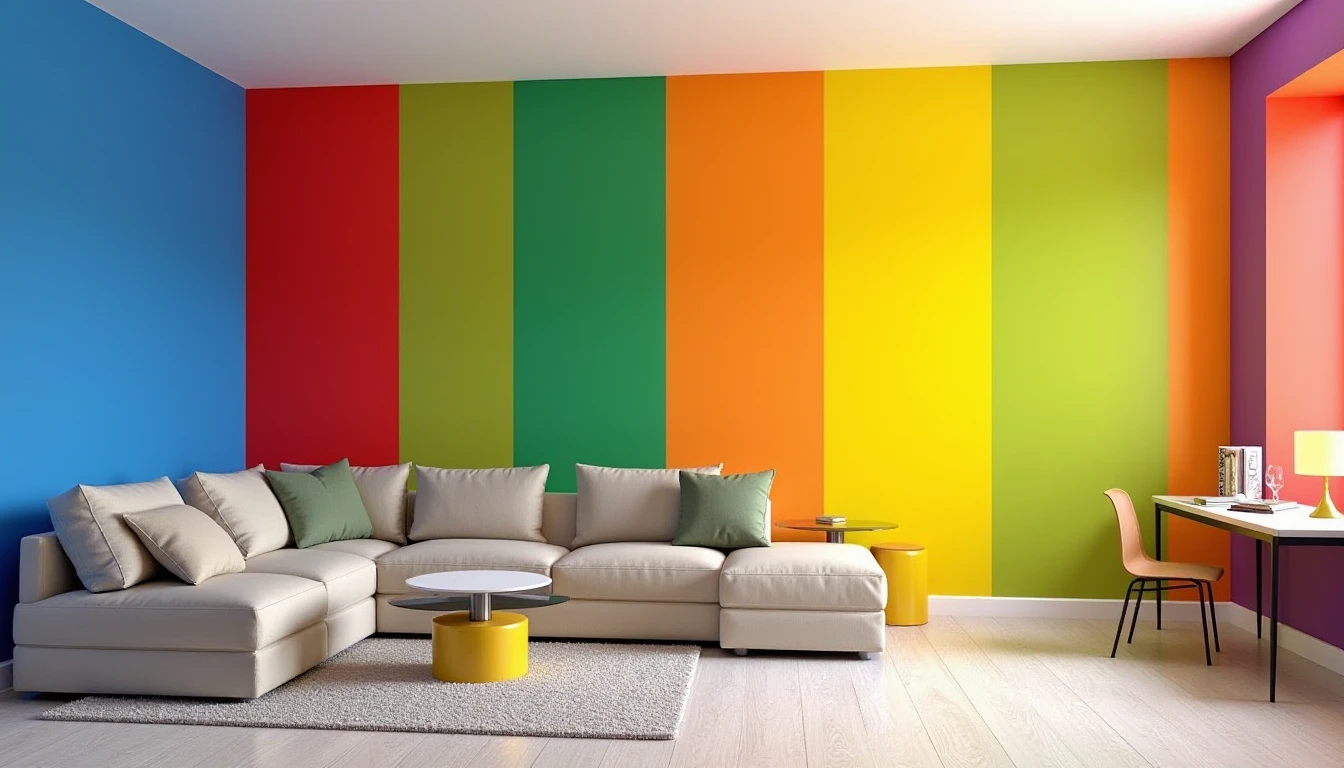The Power of Color Psychology
In the realm of interior design, color choice is not merely an aesthetic decision; it’s a powerful tool that can influence mood, behavior, and even our physiological responses. Understanding the psychological effects of colors allows designers to create spaces that enhance well-being and functionality.
Color psychology is deeply rooted in human evolution and cultural associations. For instance, green, often associated with nature, induces calmness and harmony, while red, historically linked to fire and blood, stimulates excitement and passion. These inherent connections between color and emotion form the foundation of interior design decisions.
When choosing colors for residential interiors, it’s crucial to consider the room’s purpose and desired atmosphere. A bedroom designed for relaxation might opt for calming blues or greens, whereas an energizing yellow could be ideal for a home office where creativity and focus are paramount.

Warm Colors – Inviting Harmony
Warm colors like red, orange, and yellow evoke feelings of warmth, comfort, and energy. These hues can create cozy atmospheres perfect for social gatherings or intimate settings. Red, in particular, has been shown to stimulate appetite and conversation, making it an excellent choice for dining rooms.
However, warm colors must be used judiciously; overly saturated reds can induce stress, while bright yellows might cause anxiety in some individuals. To balance these effects, designers often incorporate neutral tones or softer shades of warm hues.
Orange is a versatile color that combines the energy of red with the warmth of yellow. It’s ideal for rooms where creativity and enthusiasm are encouraged, such as home offices or creative studios. Its ability to stimulate conversation makes it an excellent choice for living rooms or dining areas designed for social interaction.
Cool Colors – Calmness and Clarity
Cool colors like blue, green, and purple evoke feelings of tranquility, clarity, and sophistication. These hues are often associated with nature and the sky, creating a sense of calm and balance in residential interiors.
Blue is renowned for its calming effects, making it an ideal choice for bedrooms or meditation rooms where restful sleep and mental relaxation are crucial. However, overuse of blue can induce feelings of sadness or coldness, so it’s essential to pair it with warmer tones or accents.
Green is a versatile cool color that promotes harmony and balance. It’s often used in living spaces designed for relaxation and rejuvenation. Its natural associations also make green an excellent choice for eco-friendly homes or rooms featuring indoor plants.
Purple combines the stability of blue with the energy of red, creating a hue associated with creativity, spirituality, and royalty. In residential interiors, purple can be used to create intimate spaces that encourage introspection or stimulate creative thinking.
Neutral Colors – Versatility and Balance
Neutral colors like white, beige, gray, and black serve as essential foundations in interior design. They provide balance, versatility, and a canvas upon which other colors and accents can thrive.
White is often associated with purity, cleanliness, and simplicity. It’s an excellent choice for creating open, airy spaces that feel expansive and bright. However, overuse of white can lead to feelings of sterility or emptiness, so it’s crucial to balance it with warm accents or textures.
Black, while often viewed as a negative color, serves vital functions in interior design. It creates contrast, adds depth, and defines space when used strategically. Black accents can add sophistication and elegance to any room but should be balanced with light colors to avoid overwhelming the space.
Gray is a versatile neutral that bridges cool and warm tones. It provides balance without overpowering other elements in a room. Light grays work well as background colors, while darker grays can serve as focal points or accents.
Color Combinations – Harmony and Contrast
Effective color schemes often combine multiple hues to create visual harmony or striking contrasts. Understanding color theory helps designers choose complementary or analogous colors that enhance each other without clashing.
Complementary colors are opposite each other on the color wheel, such as blue and orange or red and green. When used in interior design, they create dynamic contrast and visual interest. However, it’s essential to use them judiciously; too much contrast can be overwhelming.
Analogous colors sit next to each other on the color wheel, sharing similar properties while offering subtle variations. Examples include blue-green and yellow-green or red-orange and yellow-orange. Analogous schemes create a sense of harmony and balance when used in residential interiors.
Monochromatic schemes use various shades and tints of a single hue. This approach creates a cohesive, sophisticated look that’s both calming and visually interesting. Monochromatic color palettes are versatile, working well in any room or style.
The Impact of Color on Mood
Color choice can significantly influence mood and behavior within residential spaces. Understanding these psychological effects allows designers to create environments that promote relaxation, productivity, creativity, or social interaction.
Yellow is often associated with joy, optimism, and cheerfulness. It’s an excellent choice for living rooms or kitchens where warmth and sociability are desired. However, bright yellow can also cause anxiety in some individuals or lead to overstimulation when used excessively.
Blue promotes feelings of calmness and tranquility, making it ideal for bedrooms or meditation rooms. Its cooling effects can be particularly beneficial during hot summer months, helping create a soothing sleep environment.
Green is often associated with nature, growth, and harmony. It’s an excellent choice for living spaces designed to promote relaxation and balance. The calming properties of green also make it an ideal color for home offices or creative studios where mental clarity and focus are essential.
Cultural Considerations in Color Choice
When designing residential interiors for diverse cultural audiences, understanding the symbolic meanings associated with colors is crucial. What may be considered positive in one culture could have entirely different connotations elsewhere.
For example, white is often associated with purity and cleanliness in Western cultures but represents mourning in many Eastern countries. Similarly, red symbolizes luck and prosperity in China but can denote danger or aggression in other contexts.
Designers must also consider regional preferences when choosing color palettes for residential interiors. For instance, earthy tones like browns and greens are popular in Scandinavian design due to their connection with the natural landscape. Vibrant colors like orange and yellow are often used in Mediterranean homes, reflecting the region’s warm climate and colorful heritage.
By understanding cultural considerations, designers can create inclusive spaces that resonate positively with diverse audiences while still adhering to principles of color psychology in interior design.

